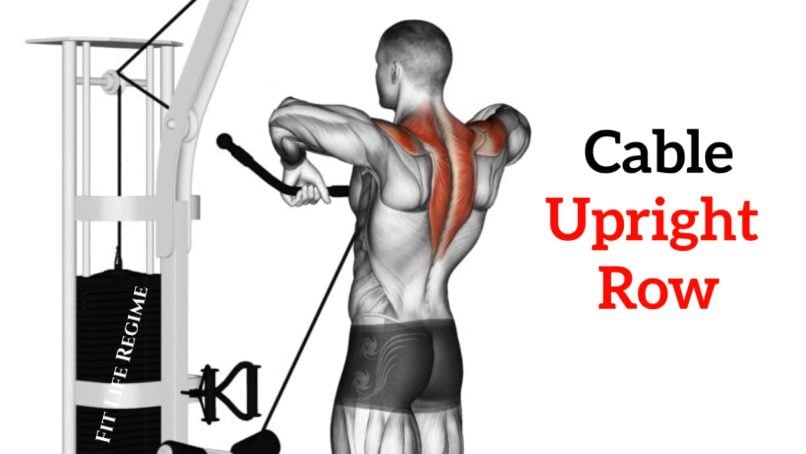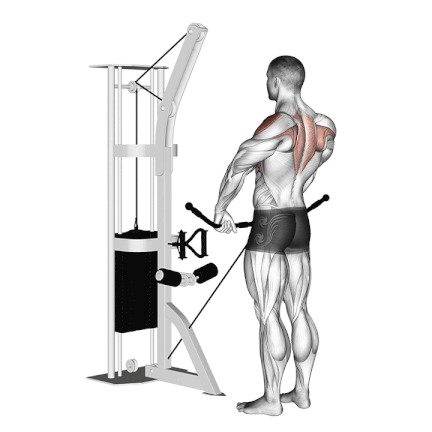The cable upright row is a compound exercise primarily targeting your shoulder muscles, specifically the lateral (side) deltoids. It also activates muscles in your upper back, like the trapezius (traps), and involves your biceps for assistance.
The cable upright row is one of the best variations of the upright row that helps to build the shoulders and trapezius muscles.
It is performed using a cable machine with an attached handle or bar. The exercise involves pulling the handle or bar vertically upward while keeping the elbows higher than the forearms.
The cable variation provides constant tension throughout the movement and provides a smoother range of motion. It ultimately increases muscle activation and hypertrophy.
Upright rows are an exercise that nearly everyone can do using various grip widths.
- Wide overhand grip
- Shoulder-width underhand grip
- Narrow underhand grip

Cable Upright Row Muscles Worked
- Primary Muscles: Lateral Deltoids and Upper Trapezius
- Secondary Muscles: Biceps brachii, Brachialis and Rhomboids
- Stabilizing Muscles: Core muscles (abdominals and obliques) & Forearms

How To Do Cable Upright Row
- Adjust the cable machine to the lowest pulley position.
- Attach your selected handle – common options include a straight bar, EZ curl bar, and rope.
- Stand with feet about hip-width apart, knees slightly bent.
- Grasp the bar with an overhand grip, slightly wider than shoulder-width. This is good for shoulder health.
- Exhale as you pull the bar up the front of your body until it reaches your lower or middle chest level. Do not pull the bar up any higher.
- Flare your elbows outwards and upwards, as if drawing them towards the ceiling.
- At the top, briefly squeeze your shoulder blades together while bringing your elbows almost in line with your shoulders.
- Inhale as you lower the bar to the starting position.
Tips and Proper Form
- Many lifters bring their hands too high, which causes internal rotation at the shoulder joint. This can lead to shoulder impingement issues over time. Limit the height of the pull to mid-chest level and focus on driving the elbows up rather than pulling with the hands.
- A narrower grip (6–8 inches) emphasises the upper trapezius, while a wider grip (shoulder-width) targets the deltoids. Experiment to find what feels best for your goals.
- Placing your hands too closely together can lead to wrist injury and shoulder discomfort. You can easily avoid these by widening your grip slightly to lift more comfortably.
- If your weight is too heavy, the movement will require momentum. Heavy lifting will take the focus away from the shoulders or, even worse, put too much stress on them.
- Brace your core and maintain an upright torso while lifting. A strong core stabilises your spine and prevents you from swinging the weight away from your centre of mass.
- Avoid rolling your shoulders forward. Keep your shoulders back and chest up as you lower the weight to maintain proper form.
- Keep your elbows slightly bent in the low position to maintain constant tension on your shoulders and trapezius muscles.

Sets and Reps
The quantity of sets and reps appropriate for cable upright rows depends on your fitness objectives and workout regimen.
Here are some general guidelines you should consider.
| Training Goal | Load (% of 1RM) | Reps per Set | Sets per Exercise | Rest Between Sets |
|---|---|---|---|---|
| Strength | 85-95% | 1-5 | 4-7 | 2–5 minutes |
| Endurance | 50-65% | 15+ | 2-3 | 30–60 seconds |
Cable Upright Row Variations
There are several variations and modifications of the cable upright row exercise that you can incorporate into your workout routine.
These variations target different muscles or provide different challenges to keep your workouts varied and engaging.
- Wide Grip Cable Upright Row: It emphasises the lateral more and a little less in the upper and middle trap. A wider grip promotes external rotation, decreasing the risk of shoulder impingement.
- EZ-Bar Cable Upright Row: The EZ-bar’s angled grips place the wrists slightly more supinated/neutral than a straight bar. This can be more comfortable for individuals who experience wrist discomfort with a completely pronated (overhand) grip on a straight bar.
- Cable Rope Upright Row: The rope allows for a more natural wrist path and reduced joint stress, which is especially beneficial for lifters with wrist or shoulder limitations.
- Single-Arm Cable Upright Row: This addresses strength imbalances between your left and right shoulders. It also forces your core muscles (especially obliques) to work harder to stabilise your torso against the unilateral load.
- Narrow Grip Cable Upright Row: Grip the bar with hands closer than shoulder width (e.g., 6-8 inches apart). This puts more on the upper trap and a little less on the lateral and rear delt. The narrow grip increases internal shoulder rotation, so keep your elbows slightly below shoulder level to minimise impingement.
FAQs
Are Cable Upright Rows Safe?
One of the main things about Cable upright exercises is that they are shoulder-friendly.
It provides constant tension on the target muscle group as you move the weight through the range of motion.
What’s the best grip width for a Cable Upright Row?
A wider grip (shoulder-width or slightly wider) is generally recommended. This reduces internal rotation at the shoulder joint, making it safer and often better for targeting the medial deltoids. Avoid very narrow grips, which increase impingement risk.
How high should I pull the bar/rope on a Cable Upright Row?
Pull until your elbows are roughly level with your shoulders, or your upper arms are parallel to the floor. Pulling higher, especially towards your chin (like in old-school barbell upright rows), significantly increases the risk of shoulder impingement without much added benefit for the medial deltoids.
References
- Schoenfeld, Brad MSc, CSCS1; Kolber, Morey J PT, PhD, CSCS2; Haimes, Jonathan E BS, CSCS2. The Upright Row: Implications for Preventing Subacromial Impingement. Strength and Conditioning Journal 33(5):p 25-28, October 2011. | DOI: 10.1519/SSC.0b013e31822ec3e3
- Int J Environ Res Public Health. Trapezius muscle timing during selected shoulder rehabilitation exercises. 2021 Jun 14;18(12):6444. doi: 10.3390/ijerph18126444.PMID: 34198674

Manish is a NASM-certified fitness and nutrition coach with over 10 years of experience in weight lifting and fat loss fitness coaching. He specializes in gym-based training and has a lot of knowledge about exercise, lifting technique, biomechanics, and more.
Through “Fit Life Regime,” he generously shares the insights he’s gained over a decade in the field. His goal is to equip others with the knowledge to start their own fitness journey.
